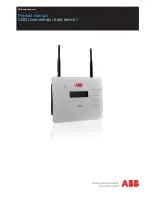
Section 7. Installation
264
Note
Cup anemometers typically have a mechanical offset which is
added to each measurement. A numeric offset is usually encoded in the
CRBasic program to compensate for the mechanical offset. When this is
done, a measurement will equal the offset only when wind speed is zero;
consequently, additional code is often included to zero the measurement
when it equals the offset so that
WindVector()
can reject measurements
when wind speed is zero.
Standard deviation can be processed one of two ways: 1) using every sample
taken during the data storage interval (enter
0
for the
Subinterval
parameter), or
2) by averaging standard deviations processed from shorter sub-intervals of the
data-storage interval. Averaging sub-interval standard deviations minimizes the
effects of meander under light wind conditions, and it provides more complete
information for periods of transition (see EPA publication "On-site
Meteorological Program Guidance for Regulatory Modeling Applications").
Standard deviation of horizontal wind fluctuations from sub-intervals is calculated
as follows:
where:
is the standard deviation over the data-storage interval, and
are sub-interval standard deviations. A sub-interval is
specified as a number of scans. The number of scans for a sub-interval is given
by:
Desired sub-interval (secs) / scan rate (secs)
For example, if the scan rate is 1 second and the data-output interval is 60
minutes, the standard deviation is calculated from all 3600 scans when the
sub-interval is 0. With a sub-interval of 900 scans (15 minutes) the standard
deviation is the root-mean-square average of the four sub-interval standard
deviations. The last sub-interval is weighted if it does not contain the specified
number of scans.
The EPA recommends hourly standard deviation of horizontal wind direction
(sigma theta) be computed from four fifteen-minute sub-intervals.
7.7.9.2.1 Measured Raw Data
•
S
i
: horizontal wind speed
•
Θ
i
: horizontal wind direction
•
Ue
i
: east-west component of wind
•
Un
i
: north-south component of wind
•
N: number of samples
Содержание CR6 Series
Страница 2: ......
Страница 4: ......
Страница 6: ......
Страница 32: ......
Страница 36: ......
Страница 38: ......
Страница 76: ...Section 5 Overview 76 FIGURE 20 Half Bridge Wiring Example Wind Vane Potentiometer ...
Страница 80: ...Section 5 Overview 80 FIGURE 23 Pulse Input Wiring Example Anemometer ...
Страница 136: ......
Страница 251: ...Section 7 Installation 251 FIGURE 46 Running Average Frequency Response FIGURE 47 Running Average Signal Attenuation ...
Страница 454: ...Section 8 Operation 454 FIGURE 104 Narrow Sweep High Noise ...
Страница 459: ...Section 8 Operation 459 FIGURE 106 Vibrating Wire Sensor Calibration Report ...
Страница 535: ...Section 8 Operation 535 8 11 2 Data Display FIGURE 121 CR1000KD Displaying Data ...
Страница 537: ...Section 8 Operation 537 FIGURE 123 CR1000KD Real Time Custom ...
Страница 538: ...Section 8 Operation 538 8 11 2 3 Final Storage Data FIGURE 124 CR1000KD Final Storage Data ...
Страница 539: ...Section 8 Operation 539 8 11 3 Run Stop Program FIGURE 125 CR1000KD Run Stop Program ...
Страница 541: ...Section 8 Operation 541 FIGURE 127 CR1000KD File Edit ...
Страница 542: ...Section 8 Operation 542 8 11 5 PCCard Memory Card Management FIGURE 128 CR1000KD PCCard Memory Card Management ...
Страница 546: ......
Страница 549: ...Section 9 Maintenance Details 549 FIGURE 133 Separate Back Shell from Module FIGURE 134 Disconnect Battery Connector ...
Страница 552: ......
Страница 610: ...Section 11 Glossary 610 FIGURE 137 Relationships of Accuracy Precision and Resolution ...
Страница 612: ......
Страница 648: ......
Страница 650: ......
Страница 688: ......
Страница 689: ......
















































